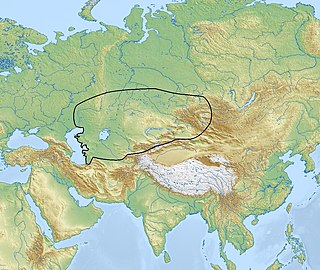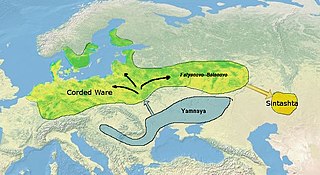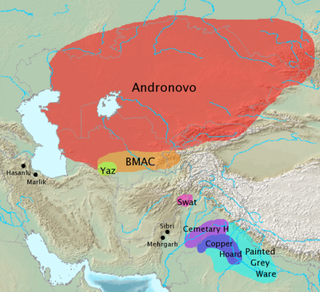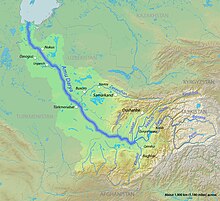
A kurgan is a type of tumulus constructed over a grave, often characterized by containing a single human body along with grave vessels, weapons and horses. Originally in use on the Pontic–Caspian steppe, kurgans spread into much of Central Asia and Eastern, Southeast, Western and Northern Europe during the 3rd millennium BC.

The Bactria–Margiana Archaeological Complex (BMAC) is the modern archaeological designation for a particular Middle Bronze Age civilisation of southern Central Asia, also known as the Oxus Civilization. The civilisation's urban phase or Integration Era, was dated in 2010 by Sandro Salvatori to c. 2400–1950 BC, but a different view is held by Nadezhda A. Dubova and Bertille Lyonnet, c. 2250–1700 BC.

The Kurgan hypothesis is the most widely accepted proposal to identify the Proto-Indo-European homeland from which the Indo-European languages spread out throughout Europe and parts of Asia. It postulates that the people of a Kurgan culture in the Pontic steppe north of the Black Sea were the most likely speakers of the Proto-Indo-European language (PIE). The term is derived from the Turkic word kurgan (курга́н), meaning tumulus or burial mound.

The Andronovo culture is a collection of similar local Late Bronze Age cultures that flourished c. 2000–1150 BC, spanning from the southern Urals to the upper Yenisei River in central Siberia. Some researchers have preferred to term it an archaeological complex or archaeological horizon. The slightly older Sintashta culture, formerly included within the Andronovo culture, is now considered separately to Early Andronovo cultures. Andronovo culture's first stage could have begun at the end of the 3rd millennium BC, with cattle grazing, as natural fodder was by no means difficult to find in the pastures close to dwellings.

The Indo-Iranian peoples also known as Ā́rya or Aryans from their self-designation, were a group of Indo-European speaking peoples who brought the Indo-Iranian languages to major parts of Eurasia in waves from the first part of the 2nd millennium BC onwards. They eventually branched out into the Iranian peoples and Indo-Aryan peoples.

The Tarim mummies are a series of mummies discovered in the Tarim Basin in present-day Xinjiang, China, which date from 1800 BCE to the first centuries BCE, with a new group of individuals recently dated to between c. 2100 and 1700 BCE. The Tarim population to which the earliest mummies belonged was agropastoral, and they lived circa 2000 BCE in what was formerly a freshwater environment, which has now become desertified.

The Srubnaya culture, also known as Timber-grave culture, was a Late Bronze Age 1900–1200 BC culture in the eastern part of the Pontic–Caspian steppe. It is a successor of the Yamna culture, the Catacomb culture and the Poltavka culture. It is co-ordinate and probably closely related to the Andronovo culture, its eastern neighbor. Whether the Srubnaya culture originated in the east, west, or was a local development, is disputed among archaeologists.

The Catacomb culture was a Bronze Age culture which flourished on the Pontic steppe in 2,500–1,950 BC.

Poltavka culture was an early to middle Bronze Age archaeological culture which flourished on the Volga-Ural steppe and the forest steppe in 2800—2100 BCE.

The Abashevo culture is a late Middle Bronze Age archaeological culture, ca. 2200–1850 BC, found in the valleys of the middle Volga and Kama River north of the Samara bend and into the southern Ural Mountains. It receives its name from the village of Abashevo in Chuvashia.

The Indo-Aryan migrations were the migrations into the Indian subcontinent of Indo-Aryan peoples, an ethnolinguistic group that spoke Indo-Aryan languages. These are the predominant languages of today's Bangladesh, Maldives, Nepal, North India, Eastern Pakistan, and Sri Lanka.

The Gandhara grave culture of present-day Pakistan is known by its "protohistoric graves", which were spread mainly in the middle Swat River valley and named the Swat Protohistoric Graveyards Complex, dated in that region to c. 1200–800 BCE. The Italian Archaeological Mission to Pakistan (MAIP) holds that there are no burials with these features after 800 BCE. More recent studies by Pakistani scholars, such as Muhammad Zahir, consider that these protohistoric graves extended over a much wider geography and continued in existence from the 8th century BCE until the historic period. The core region was in the middle of the Swat River course and expanded to the valleys of Dir, Kunar, Chitral, and Peshawar. Protohistoric graves were present in north, central, and southern Khyber Pakhtunkhwa province as well as in north-western tribal areas, including Gilgit-Baltistan province, Taxila, and Salt Range in Punjab, Pakistan, along with their presence in Indian Kashmir, Ladakh, and Uttarakhand.

The Yaz culture was an early Iron Age culture of Margiana, Bactria and Sogdia. It emerges at the top of late Bronze Age sites (BMAC), sometimes as mud-brick platforms and sizeable houses associated with irrigation systems. Ceramics were mostly hand-made, but there was increasing use of wheel-thrown ware. There have been found bronze or iron arrowheads, also iron sickles or carpet knives among other artifacts.

Takht-i Sangin is an archaeological site located near the confluence of the Vakhsh and Panj rivers, the source of the Amu Darya, in southern Tajikistan. During the Hellenistic period it was a city in the Greco-Bactrian kingdom with a large temple dedicated to the Oxus, which remained in use in the following Kushan period, until the third century AD. The site may have been the source of the Oxus Treasure.

Gonur Depe is an archaeological site, dated from 2400 to 1600 BCE, and located about 60 km north of Mary, Turkmenistan consisting of a large early Bronze Age settlement. It is the "capital" or major settlement of the Bactria–Margiana Archaeological Complex (BMAC).

The Indo-European migrations are hypothesized migrations of Proto-Indo-European language (PIE) speakers, and subsequent migrations of people speaking derived Indo-European languages, which took place approx. 4000 to 1000 BCE, potentially explaining how these languages came to be spoken across a large area of Eurasia, spanning from the Indian subcontinent and Iranian plateau to Atlantic Europe, in a process of cultural diffusion.

The Tazabagyab culture is from the late Bronze Age, ca. 1850 BC to 1500 BC, and flourished in the lower Zeravshan valley, as well as along the lower Amu Darya towards the south shore of the Aral Sea; this last region is known as Khwarazm or Khorezm. Earlier it was thought to be from ca. 1500 BC to 1100 BC and regarded a southern offshoot of the Andronovo culture, composed of Indo-Iranians, but Stanislav Grigoriev, in a recent study asserts that Tazabagyab is not part of the Andronovo cultural horizon.

The Bishkent culture or Beshkent culture is a late Bronze Age archaeological culture of southern Tajikistan, dating to c. 1700 – 1500 BC. It is primarily known from its cemeteries, which appear to have been used by mobile pastoralists.
The Inner Asian Mountain Corridor (IAMC) was an ancient exchange route ranging from the Altai Mountains in Siberia to the Hindu Kush, which took shape in the 3rd millennium BCE. The expansion of the Indo-European Andronovo culture towards the Bactria-Margiana Culture in the second millennium BCE took place along the IAMC, giving way to the Indo-Aryan migration into South Asia.

The Qäwrighul culture is a late Bronze Age culture which flourished along the Kongque River in Xinjiang from ca. 2100 BC to 1500 BC, and is one of the cultures of the Tarim mummies. It is considered as part of the Xiaohe culture, with its Xiaohe cemetery slightly to the south.
























